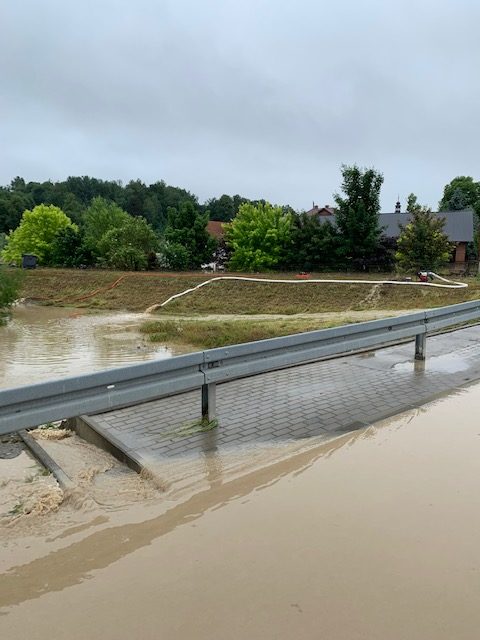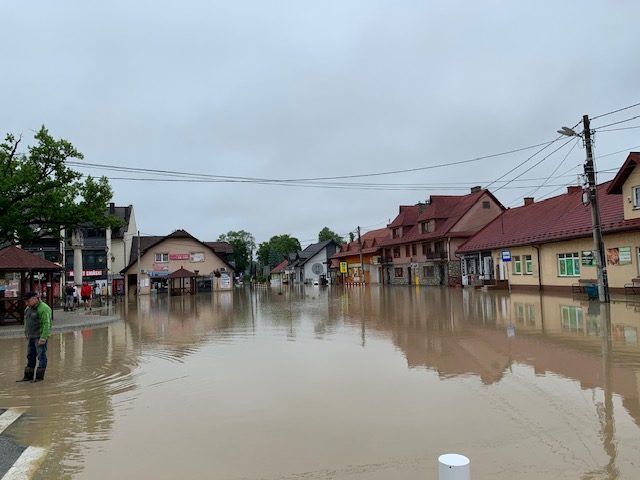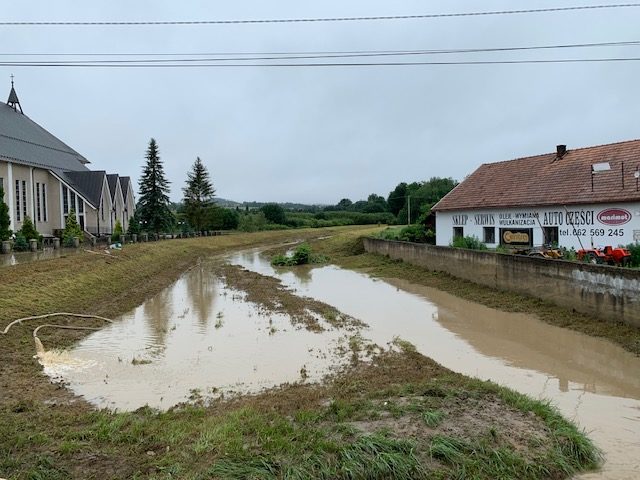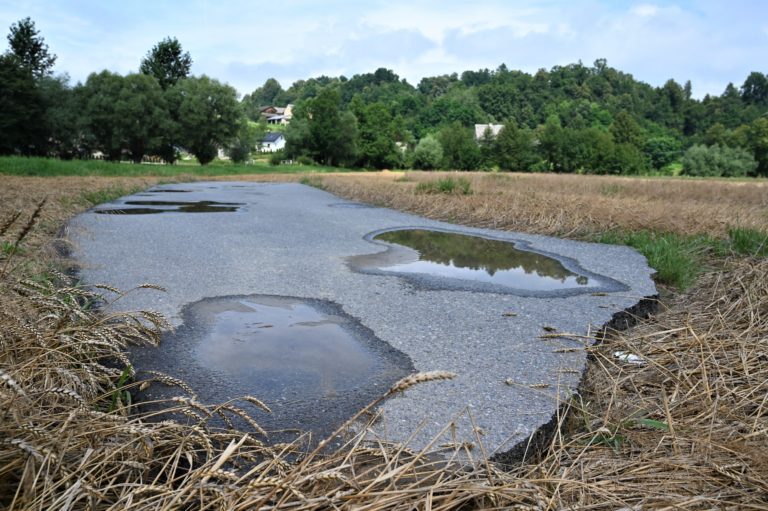The change in the structure of precipitation, which we’ve been dealing with in recent years, when up to 150 litres of rain per square meter per day can fall, and the mountain topography cause flash floods and numerous flooding to occur in some regions of Poland. They cause material losses and are traumatic for the inhabitants – especially since the buildings are often located on flood plains. Mountain rivers and streams pose a particular threat. Such places require appropriate investments carried out by Polish Waters.
In order to reduce the risk of flooding, the social awareness of residents and local government officials is also important, due to the threat posed by settling in floodplains, especially in natural depressions and river valleys, where sudden and abundant rains may lead to sudden floods. This includes the STOP FLOOD project, which is currently being implemented by Polish Waters, serves as its purpose. More on this topic: https://stoppowodzi.pl
Below we present a report from Łapanów, which, as a result of torrential rainfall, experienced a flash flood in June this year. We explain what was the cause and what actions should be taken to reduce the risk of further floods.
REPORT FROM ŁAPANÓW
Flash flood – like a tsunami
The element of water is as powerful as it’s unpredictable – when drought is foretold for a long time, it suddenly turns out that a flood is coming. And it’s also not what we might expect. This time the water in the river doesn’t rise slowly … Instead, a small tsunami appears – 1.5 meters high wave floods entire cities in a dozen or so minutes and then goes away just as quickly. And the destruction, loss, misfortune and trauma of the people living here remain for years. Can this be prevented? Yes, but it requires many compromises, time, work and money.

Flooded Łapanów, June 21, 2020. Photo Polish Waters
It is the night of June 20th to 21th . The residents of Łapanów are woken up by an alarm siren. It’s a fire brigade that goes to flooding associated with heavy rainfall in the mountainous areas of the municipality. Those who live by the Stradomka River, in their pyjamas, go out to check the water level, if everything is okay. After a while, they return home – the river is calm, it isn’t raining, there is no need to worry. For now…
However, the head of the Łapanów Commune Head receives information that in the nearby town – Jodłownik – there was a lot of rainfall and the water in Stradomka is getting higher. So, at 2:00 a.m., he announces an emergency. Just in case, because in Łapanów there is still no indication of an approaching tragedy.
Flash flood
Torrential rain passes through the neighboring commune of Jodłownik, falling 150 liters of water per square meter, the most in 100 years. The water doesn’t soak into the ground, everything flows down to the rivers and along with them – to other places. At 4:00 a.m., the level of the Stradomka River in the Łapanów commune, from 1 meter rises to 6 meters. A 1.5 meter long wave floods the town of Łapanów in less than 20 minutes. – It was a huge surprise. Hardly anyone heard the sound of water, people were asleep. As they realized, this was already the wall of water. The firefighters said that when they went to evacuate the inhabitants, they had calf-deep water, and a moment later they returned to the rope, because the water was up to the neck – says Andrzej Śliwa, Head of the Łapanów Commune.
– This is a classic example of the so-called flash flood – a short-term but very intense storm is coming. The amount of water that drops in this short time is so large that it doesn’t have enough time to sink into the ground – so it flows into to the riverbed. In this way, the water level in the river rises rapidly and the adjacent area is flooded, along withal the entire infrastructure, buildings and green areas. There is also a high speed of this water, which destroys and carries away whatever it encounters on its way. It pulls out trees, destroys buildings, bank fortifications, roads, bridges, footbridges, culverts. As soon as it appears, the water goes away – explains Radosław Radoń, Deputy Director for Protection Against Floods and Droughts of the Regional Water Management Authority in Kraków.
In Poland, we are not used to such phenomena. Most of the floods to far – such as in 1997 or in 2010 – were quite different. There, water was slowly flowing in, flooded very large areas and stood for days or even weeks, so it could be expected and prepared for it. There was no such possibility here.
River valley – like the neck of a bottle
The main cause of this disaster was the unfortunate development of the river valley. Łapanów is located on the left side of the Stradomka River, where it’s protected by flood embankments. On the right side, there is a recreational reservoir that was thoroughly modernized a few years ago. The area around was raised and fenced, so that the river valley was narrowed very much – like a neck in a bottle.
The rushing water, flowing from the main parts of the catchment area, came across this river narrowing and then overflowed through the crown of the embankment. And, as in the pool – the water poured in, but through quite high shafts, there was no way to flow out. Most of the town was under water. In Łapanów itself, the market square was flooded, two churches (including one historic one, which had just been restored after the flood of 10 years ago), a kindergarten, shops, commercial premises, private houses… Everything suddenly found itself under water. The inhabitants of the surrounding villages also suffered, especially those who live or have land near the river.
-Here, the land slipped and the river took about 15-20 acres of my field, my land. Not only do I’ve losses in crops, I also lost a lot of fields … In this place where we are standing, there’re 3 meters of water, only tree branches, the water reached the road. It washed it up and picked up a piece of asphalt and carried it to the neighbor’s field. It didn’t even turn it. Please think what power it was – says Mr. Czesław, a resident of the Łapanów commune. – One friend, Zbyszek, said that he hadn’t seen such water yet. And he’s been here since childood. Everything here was flooded – he adds.
At two farmers near the river, the entire farms went under water. Animals also drowned. – Only the cows survived – stretched their necks so that it wouldn’t sink. For the rest of the farmers, the water went through the crops and destroyed them – enumerates Mayor Andrzej Śliwa. – 100 farmers reported damage related to the flooding of farms. The inhabitants of the commune also submitted 79 applications for flood benefits, and about 55 additionally now want to apply for co-financing of renovation services. The scale of the damage is enormous. Also, entrepreneurs have suffered huge losses, many have already given up on renewing their business activities. For them, there’s no support from the state, it’s only for residents and private persons – he says.

Flash flood, rapid reaction
– As soon as we received information about the situation, we went to Łapanów in the morning – recalls director Radoń. – We made two 1.5-2 m wide trenches in the embankment, so the water began to fall. At the moment, the ditches are already buried, the embankments have been sealed with foil, so we can start working on a larger scale – he stresses.
At. 4:00 p.m., 12 hours after flooding, there was no more water in Łapanów. 17 fire brigades pumped out water from the basements of the buildings below. There was only a huge amount of silt everywhere. Residents of the village took their damaged, flooded things out of their homes. 420 tons of flood rubbish were removed.
A few days later, the Regional Water Management Board in Kraków esented plans to build new and expand the existing embankments in Łapanów and to build two quite large retention reservoirs above (Zegartowice and Lubomierz), so that in the future, in such situations, they would take over this water before it reaches the town. This combination will guarantee that the events of June this year. Will not happen again. Works related to the modernization and expansion of the embankment are to be completed at the turn of 2022 and 2023, and the retention reservoirs, according to the plan, will be built by 2026.
– We’re pleased that retention reservoirs were conceived with two functions: anti-flood and anti-drought. We’re also waiting for the construction and modernization of the embankment as for salvation. And until then, for these 2-3 years, we will still feel fear. Because the trauma will remain – says the head of the Łapanów commune. – There’re still facilities in the commune that haven’t been renovated after the flood 10 years ago, and now the same thing awaits us again. We have losses alone for about PLN 3.8 million, and for the renewal of the entire infrastructure it will probably be another PLN 10 million – he enumerates.
Broken road in Łapanów, August 2020. Fot. Polish Waters
You have to be prevented, not cured
Could the flood in Łapanów be prevented? Theoretically yes. But in practice, it would be almost impossible to do. Certainly not now. In the future – yes, but it will take at least a few years. Because the interests and welfare of many groups are at stake here – on the one hand, the inhabitants of these areas, farmers, local governments, and on the other, also the natural environment and pro-ecological organizations that defend it. And all these interests of Polish Waters must take into account when planning their activities. Contrary to appearances, it isn’t an easy task.
– Polish Waters try to draw conclusions from what is happening. In fact, the phenomenon of flash floods is intensifying in more areas of the country, especially in the south of the country. One thing is a changing climate and torrential rainfall, while the other is the building of areas and sealing of catchments – i.e. removing green areas. This includes shrubs, trees, but also meadows and pastures that absorbed rainwater. They’re replaced by concrete, cobblestones, which means that water, especially in heavy rainfall, has nowhere to soak in, so it quickly flows into the riverbed, which increases the risk of flooding – explains director Radosław Radoń.
So there’re and will be more frequent situations in which there will be no time to prepare for the arrival of ‘big water’. Therefore, it’s necessary to take action to prevent floods and protect the inhabitants from them. And this, in turn, requires large investments, but also a lot of time.
– The biggest problem is the cost of building these devices, it counts in billions of zlotys … That’s why we’ve to create priority lists and choose what is most important. In our country, the largest number of such flood protection investments are currently implemented in Kraków. We also have a large anti-flood program in Sandomierz – a city that suffered exceptionally in the 2010 flood, at the Oświęcim junction and in Tarnów. These are our priorities, but we also do not forget about smaller towns and smaller watercourses, because everyone deserves flood protection – emphasizes director Radoń.
Resettlement of People as a Way to Avoid Floods?
Investments related to the construction of embankments or reservoirs, however, often involve interference in the natural environment – e.g. tree felling. And here there’s often a controversial issue – isn’t it better to relocate people living near the river?
– Probably every rational person thinks that resettlement of people from places where there is a flood risk is a very good solution. Yes, it would be the best solution, which wouldn’t involve the construction of expensive reservoirs, embankments … But over 15 million people live in potentially flood-prone areas in our country. Moreover, we must also remember that in Poland, people are very much attached to the land, to their fatherhood. In some cases so large that they cannot imagine moving out of the places where they have settled their entire lives. On the other hand, especially in mountainous areas, there is a dense network of towns and cities, which are usually located along rivers and streams. In the upper parts of the mountains and hills occur erosive – so houses can be destroyed due to landslides, and in flat areas, along rivers, there are floodplains.
Apart from the aspect of the terrain, in order to move the inhabitants to another place, the whole town has to be built from scratch: infrastructure, bring the media to houses, provide access to public buildings: schools, hospitals, etc. The costs would be enormous. Not to mention the construction of residential buildings. It’s therefore often much wiser to prevent flooding where people have lived for years.
It’s worth talking
In Kraków, in connection with the modernization of about 20 km of flood embankments, over 2,800 trees have been designated for logging. This idea didn’t appeal to pro-ecological environments. – We learned that due to the expansion of the embankments, almost 3,000 trees are being cut down. First, we checked if it was true. Unfortunately, it was confirmed. So we decided that we would protest, because you cannot simply cut down 3,000 trees, all of them valuable species. But before it happened, it turned out that the Kraków board of Polish Waters is willing to talk about the fact that it will be possible to significantly reduce the scale of this felling – recalls Piotr Cieśla, representing the grassroots initiative “Rescue Operation for Kraków”.
– We invited ecological organizations to join us, because conversation and cooperation is the best from of achieving our goals. We always want to be fair, so we decided that if we can save trees, we can do it together. We also care about it. We signed a letter of intent with six ecological organizations on this matter, and we also managed to invite the University of Agriculture in Kraków to cooperate. The local Department of Forestry is to help us reassess whether all the trees that have been cut down must be cut down, or whether parts cannot be saved. Together with activists of these ecological organizations, we also carried out a site visit. Now we’re preparing for an action that will allow us to make a dendrological inventory again and indicate which and how many of these trees will be removed and how many we will be able to save – explains director Radosław Radoń.
But that’s just one action. Regardless of it, the Polish Waters started cooperation with the Kraków City Office on replacement plantings. They’re to be planted on one of the plots near the local large water reservoir Bagry. Another – near the Malinówka stream, where beavers feed. These activities were also positively received by pro-ecological communities.
The cooperation of Polish Waters and pro-ecological organizations is already a kind of success – on both sides – emphasizes the representative of the “Rescue Operation for Kraków”.
– Unfortunately, the construction or modernization of flood embankments is often associated with tidying up the area by cutting down trees. Our main goal is to protect human life, but we mustn’t forget about other equally important matters. Such an important issue, both for ecologists and for us, is the protection of the environment and green areas, especially in cities where each tree is valuable due to the fact that they are built up with an increasing number of concrete settlements. The more green areas, the better for all of us, for people, nature, and it doesn’t matter who we are or what we do. In addition, it should also be mentioned that trees reduce the phenomenon of rapid surface run off, which results in rapid floods. Therefore, as you can see, saving these trees is in the interest of all parties -explains the director Radosław Radoń.
Author: Renata Struzik




